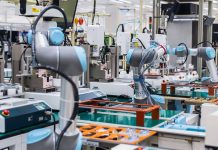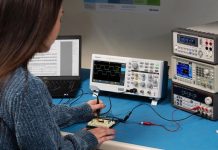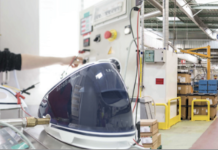Renting and servitisation are the two new concepts Cosberg offers the market for the world of assembly lines.
Digitalisation brings great benefits to industrial processes. An interesting example comes from Cosberg, a company from Terno d’Isola (Bergamo) specialising in the design and production of automated assembly lines, which has developed a new business model: the rental of its machines.
For more than forty years Cosberg has been designing purpose-built assembly plants for manufacturing industries from all over the world.
All the solutions developed have always been the result of a path of innovation that has as its final stage a highly competitive servitisation model.
This roadmap runs along two parallel lines of development:
– Processes, with the objective of efficient order management (both sales and R&D project-related).
– Solutions, understood as innovation applied to assembly plants, with a view to a higher level of maintainability and reconfigurability, to feed a servitisation and circular economy model.

A route developed in four stages
Developing a servitisation model is not easy; it requires a major rethinking of one’s business models. Cosberg did this by following four interconnected and closely sequential steps.
1. Standardisation and modularity
Two approaches that Cosberg has always applied both in its processes (codifications with nomenclature, modules and procedures are the foundations) and in its products (plants are modular and the production units are standardised, both mechanically, software and electropneumatically).
2. Digitalisation
Digitalisation involves:
– Processes side, the integration of innovative digital tools within the entire business process of value generation (innovation, design, purchasing, production, testing and service), with the aim of making efficient activities and at the same time sharing and managing the know-how generated on a daily basis.
– On the product side, the integration in the plant of monitoring and remote control software, developed in collaboration with the partner Miraitek 4.0 (Spin off of the Politecnico di Milano that offers projects, consultancy and assessment activities, supporting manufacturing companies throughout the digitisation process); first and foremost Cosberg4Machine, which monitors performance (OEE and others) and gives evidence of alarms and anomalies in real time; of the latter it displays a report, but at present does not propose a solution to the problem; then a new tool, called Smart Edge, which allows parameterisation and traceability of the entire machining process (workflow, cycle, product, recipe), making PLC reprogramming extremely flexible in the event of plant reconfiguration.
3. Artificial Intelligence
The introduction of Artificial Intelligence systems could not be effective without a prior digitisation phase. Here, Cosberg’s goal, which is in the development phase, is to design processes and products that are manageable even by non-expert operators, without the need for documentation or specific technical expertise. The idea is to develop intelligent systems that, appropriately fed by company know-how, can provide predictions, solutions and make decisions.
4. Servitisation
Cosberg servitisation cannot be completed without first untangling the previous phases.

Basic considerations for servitisation
The strategic rationale behind the Cosberg Servitisation Model considers a number of aspects:
Global market
The global size of the market poses obstacles to the speed of service due to significant geographical, if not cultural, distances. Criticality suffered by Italian plant manufacturers without their own after-sales network in international markets.
Continuity of production
There is a tendency for manufacturing companies to demand from plant manufacturers an ever-increasing guarantee on the continuity of their own production capacity, which is expressed precisely through rapid assistance anywhere in the world. What is required is an integrated product-process-service solution, based on remote-controlled technologies.
Skills shortage
The combination of production growth, demographic decrease in advanced countries and a structural shortage in technical-scientific training is at the origin of a characteristic mismatch in the labour market, between labour demand and supply, as well as of specialised technicians in mechatronic disciplines, such as operators for the operation and maintenance of production facilities.
Risk of Know-How Loss
Considering the automation of production processes as a phenomenon that has taken on a consolidated and pervasive dimension, many manufacturing companies today find themselves facing a natural turnover of plant operators, with the consequent risk of an irreversible loss of know-how, the fruit of years of experience in the field.
Ensuring consistent performance
The efficiency of production plants depends as much on the plant’s own performance as on the skill and know-how of the operators. In view of these considerations, there is a rational basis for the construction of a competitive servitisation model whose objectives include remote plant management, with the availability of its data in real time; the emulation of the plant operator for repetitive, exhausting or critical manual tasks from the point of view of safety and ergonomics; and the emulation of the maintenance technician for added-value operations, the result of a high level of experience and know-how.

The servitisation model
The path followed by Cosberg was challenging, but they eventually arrived at the final model, which consists of three elements.
1) The Monitoring and Smart Edge systems that provide plant data, shared in real time, the basis for Artificial Intelligence processing.
2) Artificial Intelligence, which is activated in relation to the plant’s operating conditions, replicating the operator’s cognitive capabilities through guided behaviour to resolve any faults, while expert systems propose solutions to predict or adapt process parameters.
3) An Avatar Robot capable of replicating the operator’s physical capabilities.
Concerning this last point, the Avatar Robot for assembly line assistance was one of the technical innovations most appreciated by professionals and the public that visited the last edition of MECSPE in Bologna. The same Robot received the Solution Award, an acknowledgement organised by Automazione Integrata magazine, which rewards during the event the best industrial or service robotics application realised by Italian companies.

Assembly line service robot
It was certainly one of the most interesting applications at the last edition of MECSPE in Bologna. The Avatar Robot at Cosberg’s stand showed its skills in handling the machine, opening hatches, doing inspection operations or loading hoppers, through autonomous or tele-operated operations.
The project, which is still in the experimental phase, is the result of Cosberg’s industrial research, developed in collaboration with the JOiiNT LAB, a joint laboratory between the Italian Institute of Technology and the Intellimech Consortium, promoted by Confindustria Bergamo, Kilometro Rosso and the University of Bergamo to foster technology transfer and innovation in the area of collaborative robotics.
The aim of the project was to develop a robot capable of interacting with an automatic production plant, such as a Cosberg assembly and testing line, to perform typical service activities.
The basic requirement of the project was that the robot should be a flexible tool, capable of operating autonomously, but also able to intervene remotely to control it.
The solution is based on Robot Avatar technology, which consists of the combination of a collaborative robot and immersive, wearable interfaces through which the operator can control the robot intuitively, as if it were an extension of his own body.
The operator can use Robot Avatar to intervene remotely as if he were carrying out the task himself, or alternatively, he can programme autonomous tasks using his own experience, without possessing specific robotics skills.
The project represents a strong declination of the Industry 4.0 concept, linked to the enabling technology of collaborative robotics in complex and flexible production contexts. To date, the functionality of the prototype has been validated on a set of service operations that are estimated to cover 70% of Cosberg machine interventions.
This is the result of a path of innovation that Cosberg has been facing for years and whose final stage is a highly competitive servitisation model.



